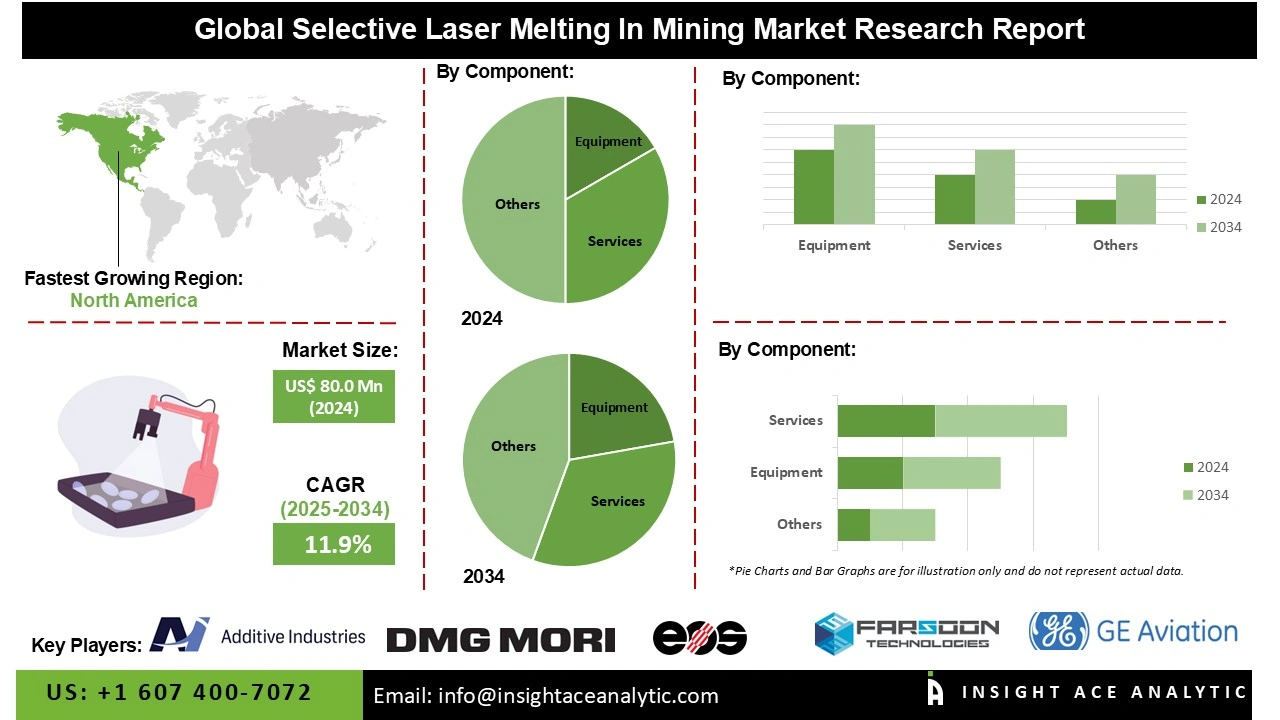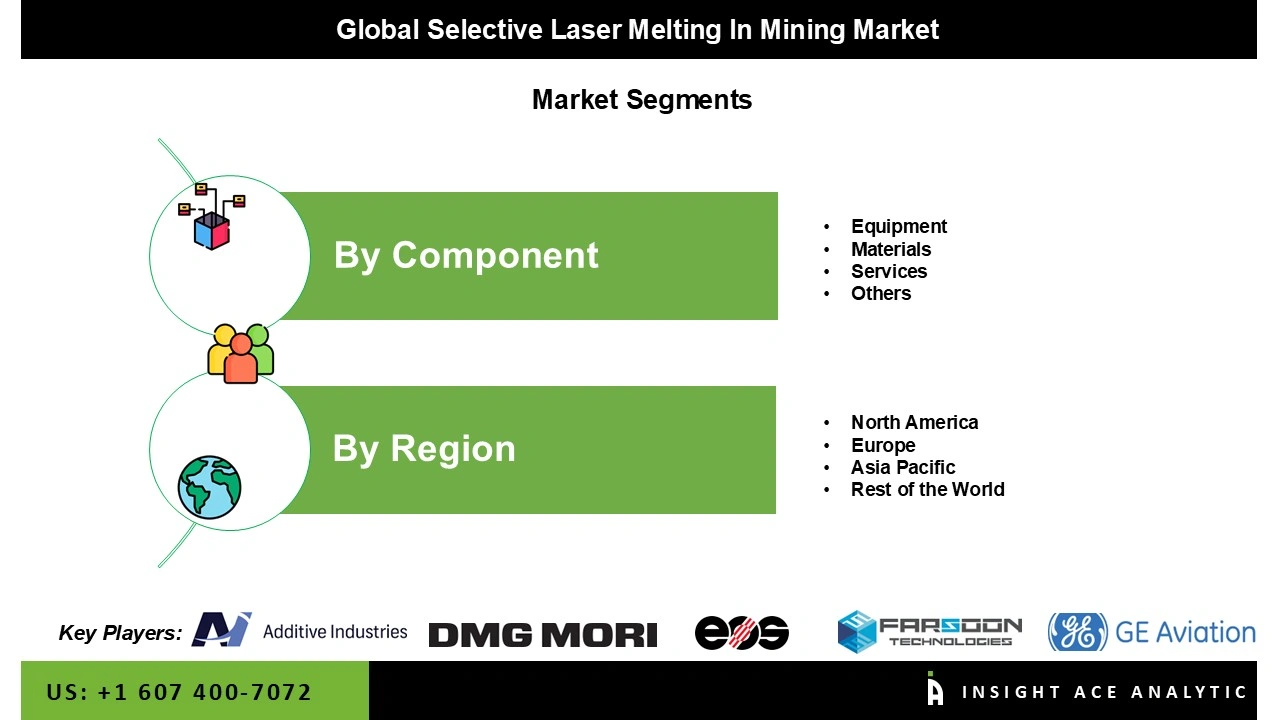Selective Laser Melting In Mining Market Size is valued at US$ 80.0 Mn in 2024 and is predicted to reach US$ 245.1 Mn by the year 2034 at an 11.9% CAGR during the forecast period for 2025-2034.

In the mining industry, selective laser melting (SLM) is a process that creates intricate, robust, and personalized parts for mining machinery and operations using high-precision metal 3D printing technology. To make items with complex geometries that are challenging or expensive to produce using conventional machining or casting methods, a laser selectively melts layers of metal powder, such as steel, titanium, or nickel alloys. SLM enables the mining industry to rapidly produce wear-resistant tools, lightweight yet robust components, and spare parts that enhance machine performance and minimise downtime. The increasing need for rapid, efficient on-site production of essential metal components drives the growth of selective laser melting in the mining market.
Additionally, the increasing demand for additive manufacturing technologies in the mining industry is a significant factor driving the growth of the selective laser melting market in this sector. Mining businesses are increasingly using SLM to create intricate geometries and unique patterns that are not possible with standard production methods. Moreover, the ongoing technological developments in SLM machines continue to propel the expansion of the selective laser melting market in mining.
The technology's capacity to create complex, topology-optimised, and consolidated parts, replacing multi-piece assemblies with lighter, stronger single-piece components, offers fuel and energy savings, reduced maintenance costs, and operational efficiencies that appeal to mining companies looking to cut costs overall. Furthermore, the selective laser melting market in mining is greatly impacted by increased R&D expenditures in industrial technology. Both the public and private sectors are funding research and development (R&D) projects aimed at advancing additive manufacturing techniques.
Some of the Key Players in Selective Laser Melting In Mining Market:
· Trumpf GmbH + Co. KG
· 3T Additive Manufacturing
· Nikon SLM Solutions AG
· Renishaw plc
· Additive Industries
· Farsoon Technologies
· GE Additive
· DMG Mori AG
· EOS GmbH
· Wipro 3D
The selective laser melting in mining market is segmented by component. By component, the market is segmented into equipment, services, materials, and others.
In 2024, the equipment category held the largest share in the selective laser melting in mining market. The increased use of sophisticated 3D printing technologies, which enhance operating efficiency and minimise material waste, is driving the robust growth of the equipment segment. To create intricate metal components with extreme precision for drilling tools, wear-resistant parts, and specialized machinery, mining companies are using SLM technology. The ability of SLM machines to produce robust, lightweight parts that prolong the life of mining equipment and reduce maintenance costs and downtime further supports the expansion of the selective laser melting market in mining.
In 2024, the Selective Laser Melting (SLM) mining market in North America held the largest share, driven by the region's well-established mining and equipment manufacturing industries, as well as its early adoption of cutting-edge additive manufacturing technologies. The requirement for sophisticated, lightweight, high-performance metal components that enhance machine reliability and minimise downtime in challenging mining environments is a significant benefit of SLM technology, further propelling the growth of selective laser melting in the mining market.
Furthermore, the United States remains a major centre for innovation in additive manufacturing, driven by robust R&D activity, increasing investments in industrial 3D printing, and the rapid adoption of SLM machines in mining-related industries, which accelerate technology spillovers and promote regional market expansion.
Over the forecast period, the Asia Pacific region is expected to grow at the fastest rate in selective laser melting in mining, as businesses shift toward sophisticated manufacturing and domestic fabrication of intricate parts. Countries such as China, Japan, and Australia are making significant investments in additive manufacturing technology to enhance equipment supply self-sufficiency and operational efficiency. In addition, manufacturers of mining equipment are investigating SLM for creating complex components used in extraction and processing equipment, driven by the increased focus on precision engineering, reduced material waste, and energy-efficient production. Government initiatives are accelerating the integration of smart manufacturing technology across regional industries.
|
Report Attribute |
Specifications |
|
Market Size Value In 2024 |
USD 80.0 Mn |
|
Revenue Forecast In 2034 |
USD 245.1 Mn |
|
Growth Rate CAGR |
CAGR of 11.9% from 2025 to 2034 |
|
Quantitative Units |
Representation of revenue in US$ Bn and CAGR from 2025 to 2034 |
|
Historic Year |
2021 to 2024 |
|
Forecast Year |
2025-2034 |
|
Report Coverage |
The forecast of revenue, the position of the company, the competitive market structure, growth prospects, and trends |
|
Segments Covered |
By Component and By Region |
|
Regional Scope |
North America; Europe; Asia Pacific; Latin America; Middle East & Africa |
|
Country Scope |
U.S.; Canada; Germany; The UK; France; Italy; Spain; Rest of Europe; China; Japan; India; South Korea; Southeast Asia; Rest of Asia Pacific; Brazil; Argentina; Mexico; Rest of Latin America; GCC Countries; South Africa; Rest of the Middle East and Africa |
|
Competitive Landscape |
Trumpf GmbH + Co. KG, 3T Additive Manufacturing, Nikon SLM Solutions AG, Renishaw plc, Additive Industries, Farsoon Technologies, GE Additive, DMG Mori AG, EOS GmbH, and Wipro 3D |
|
Customization Scope |
Free customization report with the procurement of the report, Modifications to the regional and segment scope. Geographic competitive landscape. |
|
Pricing and Available Payment Methods |
Explore pricing alternatives that are customized to your particular study requirements. |
Chapter 1. Methodology and Scope
1.1. Research Methodology
1.2. Research Scope & Assumptions
Chapter 2. Executive Summary
Chapter 3. Global Selective Laser Melting In Mining Market Snapshot
Chapter 4. Global Selective Laser Melting In Mining Market Variables, Trends & Scope
4.1. Market Segmentation & Scope
4.2. Drivers
4.3. Challenges
4.4. Trends
4.5. Investment and Funding Analysis
4.6. Porter's Five Forces Analysis
4.7. Incremental Opportunity Analysis (US$ MN), 2025-2034
4.8. Global Selective Laser Melting In Mining Market Penetration & Growth Prospect Mapping (US$ Mn), 2024-2034
4.9. Competitive Landscape & Market Share Analysis, By Key Player (2024)
4.10. Use/impact of AI on Selective Laser Melting In Mining Industry Trends
Chapter 5. Selective Laser Melting In Mining Market Segmentation 1: By Component, Estimates & Trend Analysis
5.1. Market Share by Component, 2024 & 2034
5.2. Market Size (Value (US$ Mn) & Forecasts and Trend Analyses, 2021 to 2034 for the following Component:
5.2.1. Equipment
5.2.2. Materials
5.2.3. Services
5.2.4. Others
Chapter 6. Selective Laser Melting In Mining Market Segmentation 2: Regional Estimates
& Trend Analysis
6.1. Global Selective Laser Melting In Mining Market, Regional Snapshot
2024 & 2034
6.2. North America
6.2.1. North America Selective Laser Melting In Mining Market Revenue (US$ Mn) Estimates and Forecasts by Country, 2021-2034
6.2.1.1. US
6.2.1.2. Canada
6.2.2. North America Selective Laser Melting In Mining Market Revenue (US$ Mn) Estimates and Forecasts by Component, 2021-2034
6.3. Europe
6.3.1. Europe Selective Laser Melting In Mining Market Revenue (US$ Mn) Estimates and Forecasts by Country, 2021-2034
6.3.1.1. Germany
6.3.1.2. U.K.
6.3.1.3. France
6.3.1.4. Italy
6.3.1.5. Spain
6.3.1.6. Rest of Europe
6.3.2. Europe Selective Laser Melting In Mining Market Revenue (US$ Mn) Estimates and Forecasts by Component, 2021-2034
6.4. Asia Pacific
6.4.1. Asia Pacific Selective Laser Melting In Mining Market Revenue (US$ Mn) Estimates and Forecasts by Country, 2021-2034
6.4.1.1. India
6.4.1.2. China
6.4.1.3. Japan
6.4.1.4. Australia
6.4.1.5. South Korea
6.4.1.6. Hong Kong
6.4.1.7. Southeast Asia
6.4.1.8. Rest of Asia Pacific
6.4.2. Asia Pacific Selective Laser Melting In Mining Market Revenue (US$ Mn) Estimates and Forecasts by Component, 2021-2034
6.5. Latin America
6.5.1. Latin America Selective Laser Melting In Mining Market Revenue (US$ Mn) Estimates and Forecasts by Country, 2021-2034
6.5.1.1. Brazil
6.5.1.2. Mexico
6.5.1.3. Rest of Latin America
6.5.2. Latin America Selective Laser Melting In Mining Market Revenue (US$ Mn) Estimates and Forecasts by Component, 2021-2034
6.6. Middle East & Africa
6.6.1. Middle East & Africa Selective Laser Melting In Mining Market Revenue (US$ Mn) Estimates and Forecasts by country, 2021-2034
6.6.1.1. GCC Countries
6.6.1.2. Israel
6.6.1.3. South Africa
6.6.1.4. Rest of Middle East and Africa
6.6.2. Middle East & Africa Selective Laser Melting In Mining Market Revenue (US$ Mn) Estimates and Forecasts by Component, 2021-2034
Chapter 7. Competitive Landscape
7.1. Major Mergers and Acquisitions/Strategic Alliances
7.2. Company Profiles
7.2.1. 3T Additive Manufacturing
7.2.1.1. Business Overview
7.2.1.2. Key End Use/Service
7.2.1.3. Financial Performance
7.2.1.4. Geographical Presence
7.2.1.5. Recent Developments with Business Strategy
7.2.2. Additive Industries
7.2.3. DMG Mori AG
7.2.4. EOS GmbH
7.2.5. Farsoon Technologies
7.2.6. GE Additive
7.2.7. Nikon SLM Solutions AG
7.2.8. Renishaw plc
7.2.9. Trumpf GmbH + Co. KG
7.2.10. Wipro 3D
Selective Laser Melting In Mining Market by Component-
· Equipment
· Services
· Materials
· Others

Selective Laser Melting In Mining Market by Region-
North America-
· The US
· Canada
Europe-
· Germany
· The UK
· France
· Italy
· Spain
· Rest of Europe
Asia-Pacific-
· China
· Japan
· India
· South Korea
· Southeast Asia
· Rest of Asia Pacific
Latin America-
· Brazil
· Argentina
· Mexico
· Rest of Latin America
Middle East & Africa-
· GCC Countries
· South Africa
· Rest of the Middle East and Africa
InsightAce Analytic follows a standard and comprehensive market research methodology focused on offering the most accurate and precise market insights. The methods followed for all our market research studies include three significant steps – primary research, secondary research, and data modeling and analysis - to derive the current market size and forecast it over the forecast period. In this study, these three steps were used iteratively to generate valid data points (minimum deviation), which were cross-validated through multiple approaches mentioned below in the data modeling section.
Through secondary research methods, information on the market under study, its peer, and the parent market was collected. This information was then entered into data models. The resulted data points and insights were then validated by primary participants.
Based on additional insights from these primary participants, more directional efforts were put into doing secondary research and optimize data models. This process was repeated till all data models used in the study produced similar results (with minimum deviation). This way, this iterative process was able to generate the most accurate market numbers and qualitative insights.

Secondary research
The secondary research sources that are typically mentioned to include, but are not limited to:
The paid sources for secondary research like Factiva, OneSource, Hoovers, and Statista
Primary Research:
Primary research involves telephonic interviews, e-mail interactions, as well as face-to-face interviews for each market, category, segment, and subsegment across geographies
The contributors who typically take part in such a course include, but are not limited to:
Data Modeling and Analysis:
In the iterative process (mentioned above), data models received inputs from primary as well as secondary sources. But analysts working on these models were the key. They used their extensive knowledge and experience about industry and topic to make changes and fine-tuning these models as per the product/service under study.
The standard data models used while studying this market were the top-down and bottom-up approaches and the company shares analysis model. However, other methods were also used along with these – which were specific to the industry and product/service under study.
To know more about the research methodology used for this study, kindly contact us/click here